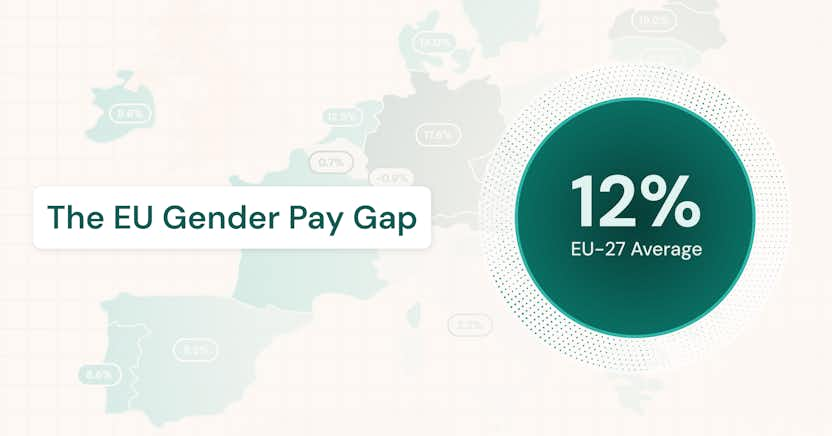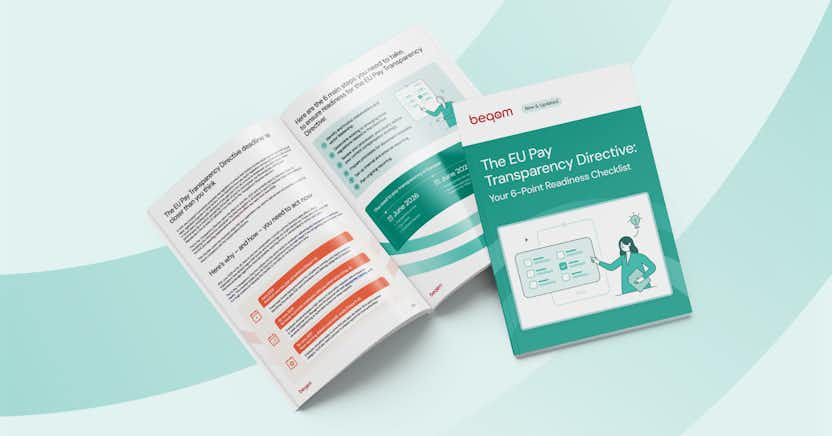The New EU Equal Pay Directive: What Employers Everywhere Need to Know

Learn more about the following beqom products
Pay transparency and equal pay are no longer just ideals in the European Union. On March 30th, the European Parliament voted to adopt the EU’s pay equity and transparency directive. The aim is to ensure equal pay for equal work regardless of gender.
Each member state will now have to devise its own laws to implement the directive, but the impact on workers, companies, and economies promises to be huge. And, similar laws could be coming to the US soon.
From an employer perspective, is this just an added burden or is there an upside to pay transparency and equity? What are the costs and benefits? What’s in it for employees?
A long road to equal pay
The concept of equal pay has been around in the European Union (EU) for at least sixty-five years, and the societal drivers of pay inequality have developed over perhaps 250 years, but the actual implementation of pay equity has been a slow and ongoing process.
1957. The principle of equal pay for equal work has been enshrined in the EU since as early as the Treaty of Rome in 1957. However, in the early years of the EU, equal pay for equal work was limited to the principle of non-discrimination on the grounds of gender.
1970s and 80s. The first EU directive on equal pay was adopted in 1975, requiring member states to ensure that men and women receive equal pay for equal work. Another directive in 1986 extended the principle of equal pay to cover equal treatment in social security schemes.
2000s. Despite these directives, there continued to be a significant pay gap between men and women in the EU. In response, the EU introduced several further measures to address the pay gap, including the establishment of the European Institute for Gender Equality in 2007 and the adoption of a new gender equality strategy in 2010.
2014. In 2014, the EU introduced a new directive on the implementation of the principle of equal pay for male and female workers for equal work or work of equal value. This directive required member states to take measures to ensure that employers provide workers with the same pay for the same job or for jobs of equal value, regardless of their gender.
2021. However, the past non-binding recommendations did not achieve the objective of more effective implementation of the equal pay principle through pay transparency. The average gender pay gap in the EU stands at 12.7%. In 2021 the EU put forth a proposal to clearly define and implement the principles of equal pay for equal work, and it now has been approved.
2023 and beyond. With the adoption of the equal pay directive in March 2023, EU-27 countries will have three years to “transpose” the requirements into local law, so by early 2026 at the latest. Employers may then be given up to a year to start complying with key provisions, so latest 2027. But many countries likely will act sooner, so companies will need to begin preparing now. And there are many solid reasons they would want to.
What do the new regulations require?
The stated purpose of the directive is “to strengthen the application of the principle of equal pay for equal work or work of equal value between men and women through pay transparency and enforcement mechanisms.” The regulations apply to companies with at least 100 workers, with some provisions applying only to those with 250 or more workers. This article will focus on the rules for larger enterprises. The key provisions designed to achieve those goals include:
Published job pay ranges: Employers need to proactively provide pay ranges for job openings, prior to job interviews.
Pay history privacy: Employers may not ask applicants about their pay history, as this can serve to perpetuate existing pay disparities.
Pay criteria transparency: Employers must provide information on the criteria used to determine pay, pay levels, and pay progression, and those criteria must be the same for both men and women.
Gender pay gap reporting: Employers have to make available sex dis-aggregated data on pay. They must provide annually—and workers may request—data on pay for work of equal value, broken down by gender, for all workers.
Pay gap reporting by worker category: Employers must provide employees with information on the pay gap between female and male workers within each category of workers.
Joint pay assessment: When pay reporting for a category of workers reveals a gender pay gap of 5% or more, where the employer cannot justify the gap on objective gender-neutral grounds, employers must conduct a pay assessment, in cooperation with workers' representatives, and must remedy unjustified gaps.
Consideration of intersectionality: While the focus is on gender pay disparity, the employer may face increased liability if analysis shows that the subjects of pay discrimination are also disproportionately members of other protected classes based on race, ethnicity, religion, etc.
Conflict with local regulations. If an EU member state already has its own pay equity and transparency requirements, the EU Directive will represent the minimum requirement, but it allows each member state to set its own additional requirements. If a member state already has laws in effect that are more favorable to employees than those in the Directive, the Directive cannot be used to reduce those existing rights.
Many companies are already doing elements of the above, but the requirements now will be formalized and enforced, creating new impetus for the establishment of consistent equal pay processes and governance. You can find the full directive here.
The many benefits for employers of pay transparency
There is work to do, certainly, but implementing pay transparency and equal pay can bring many benefits for employers that make it worthwhile for its own sake, beyond just compliance.
Attracting and Retaining Talent: Employees are more likely to stay with an employer who is transparent about pay and offers equal pay for equal work. They are also more likely to be attracted to an employer who has a reputation for being fair and transparent in compensation practices.
Improved Employee Morale: When employees feel that their pay is fair and transparent, they are more likely to be motivated and engaged in their work. This can lead to increased productivity and job satisfaction, which can ultimately benefit the employer.
Reduced Risk of Legal Action: Pay transparency and equal pay practices can help employers avoid discrimination lawsuits and other legal action related to pay equity and compliance requirements. This can save the employer time, money, and reputational damage.
Enhanced Reputation: Employers who are transparent about their pay practices and offer equal pay for equal work can build a positive employer brand. This can act as a competitive differentiator to attract top talent and help to retain existing employees. And by the way, what’s good for reputation is good for investors.
Increased Trust and Transparency: Pay transparency and equal pay practices can help build trust between employees and employers, as well as promote transparency and fairness in the workplace. This can lead to a more positive and productive work environment.
Weighing costs and benefits
As member countries work the directive into their own laws, the new regulations will undoubtedly require some resources, time, and focus for employers. What are the benefits from an employer perspective? What will the cost impact be on employers? Will the benefits outweigh the costs? How can employers best manage this new reality of transparency and equal pay?
The potential costs for employers
While pay transparency and equal pay practices can bring significant benefits to employers, there are also costs associated with implementing and maintaining these practices. Here are some of the costs employers may face:
Data Collection and Analysis: Ensuring pay transparency and equal pay requires employers to collect and analyze data on employee pay and compensation practices. This can be time-consuming and may require additional resources or software to manage the data.
Pay Adjustments: To achieve equal pay, employers may need to make pay adjustments for some employees. This can be costly, especially if the employer has a large workforce.
Training and Communication: Employers must communicate the new pay transparency and equal pay policies to their workforce and provide training to managers and employees on how to implement these practices. This can be time-consuming and require additional resources or software.
Legal Compliance: Employers must comply with applicable laws related to pay equity and equal pay. This may require additional legal counsel and compliance monitoring.
Compensation Structure Changes: To implement pay transparency and equal pay, employers may need to restructure their compensation practices. This can be costly and may require additional resources.
Overall, the costs of implementing pay transparency and equal pay practices will vary depending on the size and complexity of the organization, and on whether the organization has tools to automate the necessary tasks and ensure efficiency. However, these costs should be weighed against the potential benefits of increased employee satisfaction, productivity, and legal compliance, as well as against the costs of inaction and the potential savings that can be realized from pay transparency.
How equal pay can save costs
While some critics of pay equity reporting cite increased costs to employers, the benefits named above can bring with them significant benefits such as:
Reduced Turnover: When employees see they are being paid equitably, they are more likely to stay with their employer. High turnover rates can be costly for employers, as they must spend time and resources recruiting, hiring, and training new employees.
Increased Productivity: Employees who feel their pay is fair and transparent are generally more motivated and engaged in their work. This can lead to increased productivity and efficiency, which can save costs for the employer.
Reduced Legal Costs: By ensuring pay transparency and equal pay practices, employers can avoid legal action related to pay discrimination. This can save significant legal costs, time, and resources that would otherwise be spent on legal defense.
Improved Reputation: Employers who are known for their fair and transparent pay practices can build a positive reputation as an employer of choice. This can attract top talent and help to retain existing employees, reducing the costs associated with recruitment and turnover.
Enhanced Employee Loyalty: When employees feel they are being paid fairly, they are more likely to be loyal to their employer. This can lead to a positive workplace culture, higher levels of engagement, and reduced costs associated with absenteeism, low morale, and poor performance.
Overall, pay transparency and equal pay can save costs for an employer by promoting a positive workplace culture, increasing productivity, reducing turnover and legal costs, and enhancing the employer's reputation as a fair and equitable employer.
The cost of inaction
In addition to missing out on the benefits for recruiting, reputation, productivity, etc., failure to comply with regulations is likely to result in penalties. The EU directive instructs member states to “provide for effective, proportionate and dissuasive penalties in the event of infringements of national provisions.” Fines are to consider the gravity and duration of the discrimination and should take into consideration any intent to discriminate along with “any other aggravating or mitigating factors that may apply in the circumstances of the case, for instance, where pay discrimination based on sex intersects with other grounds of discrimination,” commonly known as intersectionality. Repeated infringements are to have additional specific penalties or other financial disincentives.
Public contracts should ensure pay equity as well, by having “pay setting mechanisms that do not lead to a pay gap between female and male workers that cannot be justified by gender-neutral factors in any category of workers carrying out equal work or work of equal value,” to be enforced by penalties and termination conditions.
Failure to comply also runs the risk of triggering court-ordered changes. The directive says that courts “should be able to require an employer to take structural or organisational measures to comply with its obligations regarding equal pay.”
Furthermore, in a court case, the directive shifts the burden of proof to the employer to prove that there has been no direct or indirect discrimination in relation to pay.
Meeting the fair pay challenge
Whether it’s to comply with the law or to attract talent, motivate your workforce, create a culture of fairness, or reduce legal risk, establishing pay transparency and equity can pay big returns.
Companies that are serious about fair pay are putting systems in place that will enable them to deliver at scale. That means automation of pay processes, transparency so that employees understand what they are being paid and why, external and internal benchmark comparison, and advanced analytics to identify, report, and fix pay gaps, identify at-risk employees, and proactively focus programs to remedy unfair practices.
What’s in it for employees?
So, how about the employee perspective? The regulations are designed to ensure workers are treated fairly when it comes to compensation. Yet the impact on employees is likely to be more far-reaching than just the paycheck. In what ways will employees likely benefit?
Whether you are in the EU, the US, the UK, or any other country, you may want to give some thought to the benefits of taking the leap to full pay transparency and equity.
Benefits for employees
Fair and transparent pay practices, as defined by the directive, can have a positive impact on employees in several ways:
Motivation and Engagement: Employees are more likely to be motivated and engaged in their work when they feel that they are being fairly compensated for their efforts. When employees feel that their pay is transparent and equitable, they are more likely to be committed to their work and to go above and beyond to achieve their goals. A study conducted by job recruiting site Indeed found that 81% of workers are more productive and engaged when they perceive themselves as paid fairly.
Retention: Fair and transparent pay can also contribute to employee retention. When employees feel that they are being paid fairly and that there is a clear path for career advancement, they are more likely to stay with the organization long-term. Another survey by PwC found that 71% of employees consider fair pay to be the most important factor when considering a change in their work environment. Equal pay is one way companies can support women’s equality and retain female workers.
Trust and Respect: Fair and transparent pay can help to build trust and respect between employees and the organization. When employees feel that their employer values their contributions and is committed to paying them fairly, they are more likely to feel respected and valued. An atmosphere of trust provides a foundation for collaboration and teamwork.
Inclusivity: Fair and transparent pay can also contribute to a more inclusive workplace culture. When pay practices are transparent and equitable, employees from diverse backgrounds are more likely to feel that they have an equal opportunity to succeed within the organization. SHRM found that 91 percent of employees who believe their organization is transparent about how pay decisions are made also said they trust that their organization pays people equally for equal work regardless of gender, race, and ethnicity.
Job Satisfaction: Fair and transparent pay can contribute to overall job satisfaction for employees. When employees feel that their pay is fair and that they are being treated equitably, they are more likely to be satisfied with their job and feel a sense of pride in their work. A survey by Clutch found that the most important workplace values for full-time employees are fair pay (55%) and fair treatment (54%).
Protection: The directive also includes measures to protect employees against retaliation for requesting pay information or for taking part in pay transparency measures. Employers must ensure that employees are not penalized in any way for requesting or sharing information about pay levels, and must provide a safe and supportive environment for employees to discuss pay issues.
Overall, fair and transparent pay can have a positive impact on employees by contributing to their motivation, engagement, retention, trust, respect, inclusivity, and job satisfaction. Motivated, engaged, loyal. Doesn’t that sound like the kind of employee you would like to have?
A growing trend globally
Of course, pay transparency is a hot topic outside the EU as well. beqom’s 2023 Leveling the Paying Field report surveyed worker attitudes toward pay equity and transparency in the US and UK and found that a large majority of Millennials (68% US, 72% UK) are more willing to work at a company that discloses its gender pay gap.
The idea of government action (like the EU directive) to enforce pay equity is not unique to Europe either. When asked whether there should be national legislation to address the gender pay gap, more than half (58%) of US respondents said there should be a law mandating companies to disclose their gender pay discrepancies.
However you feel about regulations, it seems that pay equity and transparency can yield major benefits for both workers and employers alike.
Managing pay transparency effectively
Complying with the pay transparency requirements can result in additional costs to employers, yet the costs of inaction cannot be ignored, and there even are ways that pay transparency and equity can lower costs. And, pay equity can be seen to have many strategic benefits beyond regulatory compliance.
Whether you see the new regulations as a boon or a burden, they are coming. It’s clear that large organizations will need to prepare well before they take effect, and will need to have the systems in place to support the required analysis, reporting, pay structures, processes, communications, and compliance.
To learn how beqom can help your organization support fair and transparent pay practices, contact our rewards specialists for more information.
Download beqom’s 2023 Leveling the Paying Field Report for insight into employee experiences and perspectives on the gender pay gap, pay transparency, and other aspects of compensation.








